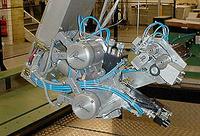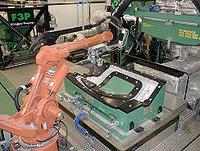Ford Programmable Preform Process (F3P) brings quality and repeatability to the production of liquid composite molded parts
BREAKTHROUGH COMPOSITE TECHNOLOGY F3P NOW AVAILABLE TO OTHER AUTOMAKERS DEARBORN, Mich., April 23 - A preforming process developed by Ford Motor Company researchers for producing composite parts for the Aston Martin V12 Vanquish has been so successful, that it's now on sale to other automakers.
Ford's Programmable Preform Process (F3P) was first used to produce the right hand and left hand body sides and upper cargo deck of the Vanquish, parts fabricated with lightweight and strong glass fiber composites.
Utilizing F3P, a robot sprays the glass fibers onto a screen. The material is then consolidated with an upper screen to form a "preform" in the shape of the part. Hot air melts and cures a thermoplastic and/or thermoset binder. Cold air then cools the binder, making the preform rigid for subsequent handling. Finally, the tool opens and the preform is removed.
The principles of the F3P process were developed by Owens-Corning Fiberglass along with Aplicator System AB and termed P4 (Programmable Powdered Preforming Process). The Automotive Composites Consortium (ACC), comprised of DaimlerChrysler, Ford Motor Company, and General Motors, further developed the P4 technology from laboratory to production scale in a collaborative research project. F3P evolved based on Ford Motor Company's technical expertise in P4 gained from participation in the ACC research program.
The F3P process, developed by Ford Motor Company Research and Advanced Engineering in Dearborn, Mich., utilizes a seven-axis robot, which provides a high degree of repeatability for the manufacture of quality products. The combination of a computer-controlled robot and state-of-the-art fiber delivery system results in a preforming process that has major technological and economic benefits.
"Previous to the development of F3P, production of large preforms for automotive composite components were too expensive and time consuming to be viable at higher volumes of production," said Dr. Charles Wu, director, Manufacturing and Vehicle Design, Ford Research and Advanced Engineering, "F3P can significantly reduce the cost and improve the quality of liquid composite molded parts."
Ford Research and Advanced Engineering worked closely with Aston Martin to make the F3P preforming process fully ready for higher volume manufacture. Aplicator System AB, Mölnlycke, Sweden, is the manufacturer of the chopper gun and two-station, production preforming machine.
Ford's partner in the commercialization of F3P is Sotira, s.a., based in St. Meloir Des Ondes France. Sotira is a leading European manufacturer of liquid molded composite components for the auto industry. Its role in developing F3P, was the industrialization of the subsequent liquid molding processes that are necessary to realize cost effective components.
This technology is now also being used on the newly launched Aston Martin DB9 for the manufacture of decklids, sills, door opening rings and decklid surrounds using liquid molding with F3P preforms.
"The F3P technology is a key enabler to making composite components that are high quality and cost efficient at Aston Martin volumes," said Jeremy Main, Director, Product Development & Motorsport, Aston Martin.
More on the process
F3P uses modern computer-controlled technology to provide a high level of consistency and accuracy. The process makes use of male and female perforated screens to produce a preform to exactly the same size and shape as the finished part. F3P uses low-cost conventional fiber rovings, which are fed to the machine via a fiber handling system.
Applicator System AB's SMART Chopper
Applicator System AB unique SMART (Servo-controlled, Multi, Adjustable, Roving Technology) chopper gun, mounted at the end of a seven-axis robot initially sprays a fiber veil on to the lower screen and air is drawn through it to hold the chopped fiber in place. The veil layer both assists in demolding of the preform and is used to achieve the required "class-A" surfaces. With the veil fiber deposition completed, chopped or continuous fibers are sprayed onto the screen, either randomly or oriented to allow efficient structural laminates to be produced.
F3P Benefits Key F3P benefits include: high-consistency preforms, precise fiber placement, a high quality "class A" surface, a controlled thickness variation, superior control of fiber distribution, "deep draw" geometry, and easy demolding.
One of the process's paramount economic benefits is the minimum level of waste produced, which is considerably lower than for other preforming processes (Less than three percent is typical).
Other advantages include: lower raw material cost than with some alternative processes such as mat-thermoforming, low energy consumption, and net shape and net size preforming, eliminating the need for trimming.
These features, particularly the use of low-cost raw materials, make F3P extremely cost-effective compared to other preforming processes.
Sotira has the capability of making F3P preforms or finished liquid molded articles for others. In addition to Sotira, Ford is licensing the F3P process to other manufactures. Information about obtaining a license to F3P and other Ford technologies is available through the Ford Better Ideas http://www.fordbetterideas.com.
Ford Motor Company, a global automotive industry leader based in Dearborn, Mich., manufactures and distributes automobiles in 200 markets across six continents. With more than 318,000 employees worldwide, the company's automotive brands include Aston Martin, Ford, Jaguar, Land Rover, Lincoln, Mazda, Mercury and Volvo.
Its automotive-related services include Ford Credit, Quality Care and Hertz. Ford Motor Company celebrated its 100th anniversary on June 16, 2003.




